OWC Mercury Electra 3G MAX 960GB Review: 1TB of NAND in 2.5" Form Factor
by Kristian Vättö on October 18, 2012 1:00 AM ESTRandom Read/Write Speed
The four corners of SSD performance are as follows: random read, random write, sequential read and sequential write speed. Random accesses are generally small in size, while sequential accesses tend to be larger and thus we have the four Iometer tests we use in all of our reviews. Our first test writes 4KB in a completely random pattern over an 8GB space of the drive to simulate the sort of random access that you'd see on an OS drive (even this is more stressful than a normal desktop user would see).
We perform three concurrent IOs and run the test for 3 minutes. The results reported are in average MB/s over the entire time. We use both standard pseudo randomly generated data for each write as well as fully random data to show you both the maximum and minimum performance offered by SandForce based drives in these tests. The average performance of SF drives will likely be somewhere in between the two values for each drive you see in the graphs. For an understanding of why this matters, read our original SandForce article.
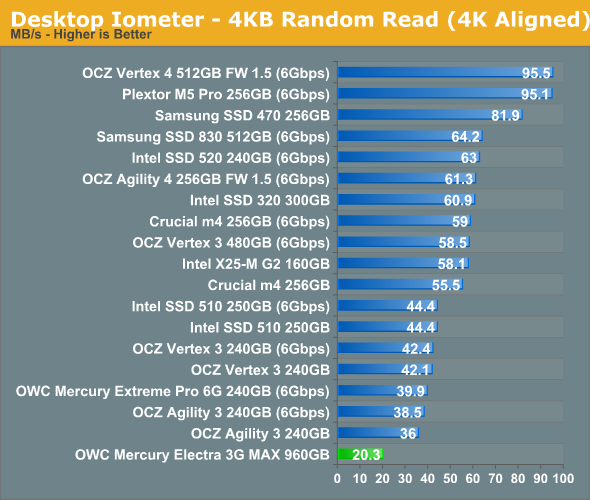
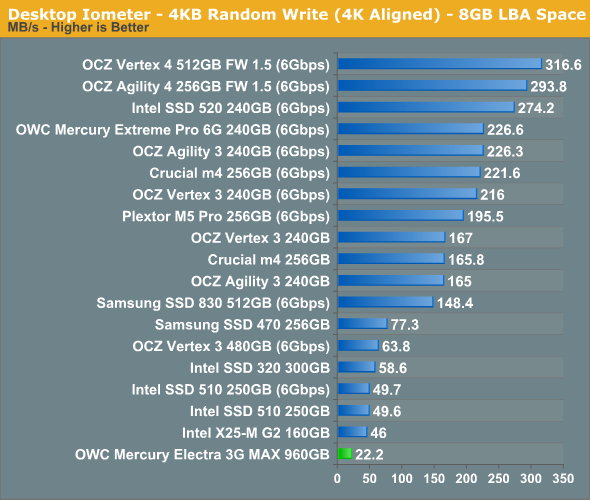
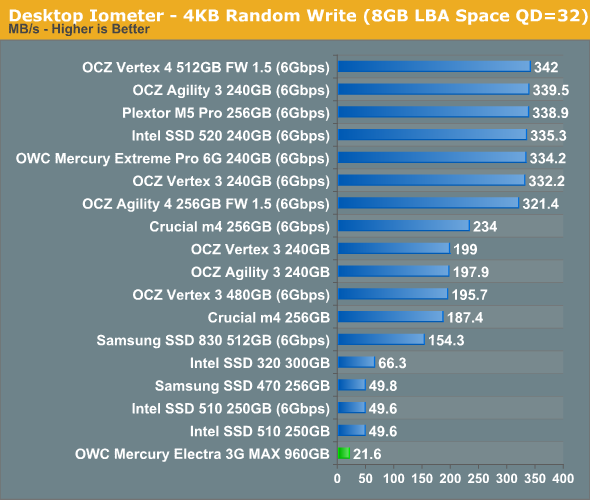
To be straight, random performance is horrible. Regardless of the queue depth and IO type (read/write), random performance tops out at around 22MB/s. I ran each test a few times to double-check but performance didn't get any better. I asked OWC if this is normal and they said it is, which also explains why OWC isn't reporting any random read/write speed figures. Ouch.
The SF-2181 controller is good for up to 60K 4KB random read/write IOPS, so that's definitely not the bottleneck. With two controllers in RAID 0, we should get random performance of over 100K IOPS at higher queue depths, although SATA 3Gbps would limit us to around 70K IOPS max. If the SSD controller is not the bottleneck, it leaves us with only one option: the RAID controller. Like I said, Siicon Image's RAID controller is not a very high-end one and the product page says it's actually a SATA to dual-eSATA controller, meaning that it's mainly aimed to be used with external hard drives, which don't offer great random IO performance to begin with. It definitely wasn't designed with SSDs in mind and I'm starting to think that OWC opted for it because there simply wasn't another viable option.
Sequential Read/Write Speed
To measure sequential performance we ran a one minute long 128KB sequential test over the entire span of the drive at a queue depth of 1. The results reported are in average MB/s over the entire test length.
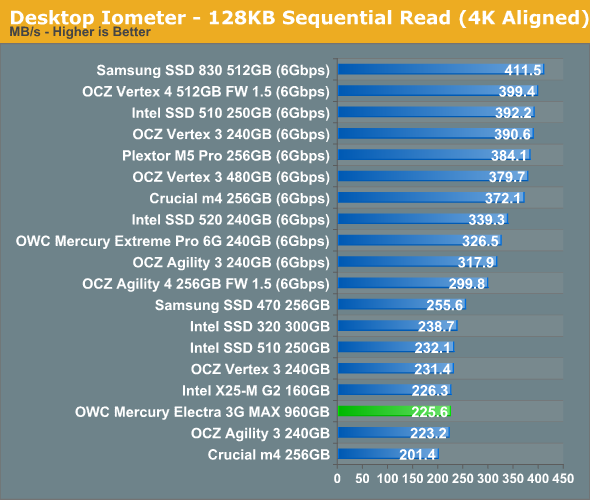
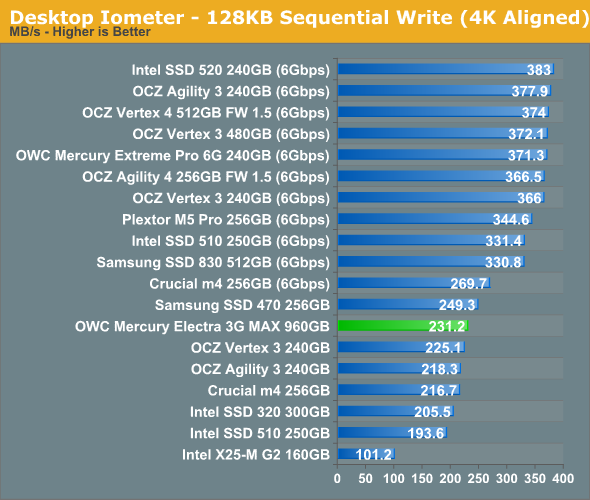
Sequential performance is much better than random speeds and now we're seeing figures typical for SATA 3Gbps SSDs. In terms of performance, there doesn't seem to be much gain from RAID 0 as for example OCZ Vertex 3 performs similarly when used in a SATA 3Gbps environment.










36 Comments
View All Comments
cyrusfox - Thursday, October 18, 2012 - link
I sort of get it, this thing is kind of affordable but in a year, with next gen Nand available128Gb/16GB), all prices will continue to crash($/gb). And high storage nand in 2.5" form factor is not all that unique. OCZ has had a 1tb drive out since at least may (OCT1-25SAT3-1T), which can be found on newegg or amazon. When you are already spending more than a grand for a drive, might as well grab one that is at least 6 Gbps compatible.Either drive will depreciate faster than is acceptable for me. I am still waiting for a $130 fire sale on an Vertez 4 256gb though, right now I have a poor mans raid 0 of a 128gb vertex 4 and a 120gb Agility 3, both of which I paid $140 plus for awhile ago. Its just as bad as when I spent $100 for 4gb of DDR3 3yrs ago. Buyers remorse, the cost of adopting tech early.
SpaceRanger - Thursday, October 18, 2012 - link
If this thing is for Audio and Video Professionals, then it's more than likely targeted for Mac users. Mac users are well known for overpaying for their hardware, so the price for this piece of steaming pile is fitting.ajp_anton - Thursday, October 18, 2012 - link
You really need to fix your chart making when performance is very low.If the performance number doesn't fit the bar, move it next to it instead of overlapping with the product name.
I commented on this years ago but nothing's happened. We don't often see the bars go so low, but sometimes they do.
Kristian Vättö - Thursday, October 18, 2012 - link
Our CMS makes the graphs automatically so I can't play with small details like where the actual number is placed. I'll pass a word to Anand and see if there is a way to fix it, because I find that irritating as well.JarredWalton - Thursday, October 18, 2012 - link
Actually, there is a way to do this Kristian: check the "outer labels" box at the top-right of the graph. I've fixed the two random write charts and regenerated.ajp_anton - Thursday, October 18, 2012 - link
Thanks, hopefully all of you remember to do this when necessary (looks like it requires manual work).For consistency between different charts, you should either make this the default, or change it so it only places them outside for too small values. Maybe even for all values below 50% of the largest.
Juddog - Thursday, October 18, 2012 - link
I don't buy that they couldn't afford to put a SATA6G connection on there. The price is already through the roof and newer SSD's hit way past the normal limits of SATA3G (some even bump up against the SATA6G limit).Kristian Vättö - Thursday, October 18, 2012 - link
OWC didn't exactly specify why they had to stick with SATA 3Gbps, they only said it was a combination of things including price, thermals and space. I wouldn't be surprised if there simply was no SATA 6Gbps controller as the market for such controllers is fairly small. I know Silicon Image doesn't have one, at least.dave_the_nerd - Thursday, October 18, 2012 - link
I have a Macbook with an HDD + SSD in an optical bay adapter, but I'd sooner duct tape an external drive to the back of the lid that overspend on something like this.Hell, I'd rather install a pair of WD Blacks and software RAID them.
Audio doesn't need as much sequential I/O as video, though, I guess.
Somebody will buy it though.
JonBendtsen - Thursday, October 18, 2012 - link
What if they used JBOD or linear raid rather than raid0?